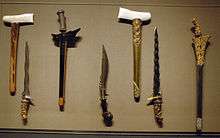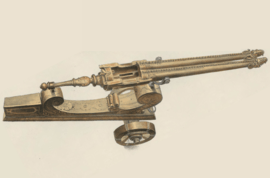Bedil tombak
Bedil tombak or bedil tumbak is a type of early firearm from the Nusantara archipelago. The weapon consist of a gun or small cannon mounted on a wooden pole, forming a type of weapon known as "pole gun" (stangenbüchse in German).[1]

Etymology
The word bedil a term in Malay language meaning gun (any type of gun, from small pistol to large siege gun).[2] The word tombak or tumbak means spear, pike, or lance.[3]
History
The introduction of gunpowder-based weapon in Nusantara archipelago can be traced back from Mongol invasion of Java (1293), where the Chinese-Mongol troops used cannon (pao) against the forces of Kediri in Daha.[4] Between 14th-15th century, numerous local sources mentioned about bedil (gun or gunpowder-based weapon), but since this is a broad term it is difficult to discern what type of weapon used in a passage.[5][6]
Ma Huan (Zheng He's translator) visited Java in 1413 and took notes about the local customs. His book, Yingya Shenlan, explained about Javanese marriage ceremony: when the husband was escorting his new wife to the marital home, various instruments were sounded, including gongs, drums, and huochong (hand cannon).[7][8]:245 It is probable that Javanese hand cannon is modelled after Chinese ones. A Chinese pole cannon from 1421 A.D. has been found in the island of Java bearing the name of Emperor Yongle (1403-1425). The gun's ignition hole is protected from the rain by a cover connected with hinge.[1]
Duarte Barbosa recorded abundance of gunpowder-based weapons in Java ca. 1510. The Javanese were deemed as expert gun caster and good artillerymen. The weapon found there including one-pounder cannons, long muskets, spingarde (arquebus), schioppi (hand cannon), Greek fire, guns (cannons), and other fire-works.[9][10] In 1511 siege of Malacca, the Malays were using cannons, matchlock guns, and "firing tubes".[11]
Local babad (historical text) of post-17th century occasionally mention bedil tombak, but they are hard to date because the babads were in the form of pupuh (poem).[12] In Lombok example of such babads were babad Lombok, babad Mengui, and babad Sakra.[13][14][15] They are also mentioned in Sundanese and Balinese texts.[16][17] During the Bali-Lombok war (ca. early 19th century-end of 19th century), a part of Karangasem troops were armed with bedil tombak.[15]
See also
References
- Zeitschrift für historische Waffenkunde. Getty Research Institute. Dresden : Verein für historische Waffenkunde. 1897.CS1 maint: others (link)
- Kern, H. (January 1902). "Oorsprong van het Maleisch Woord Bedil". Bijdragen tot de Taal-, Land- en Volkenkunde. 54: 311–312. doi:10.1163/22134379-90002058.
- Marsden, William (1812). A Dictionary of the Malayan Language. Cox and Baylis.
- Song Lian. History of Yuan.
- Nugroho, Irawan Djoko (2011). Majapahit Peradaban Maritim. Suluh Nuswantara Bakti. ISBN 9786029346008.
- "Teknologi Era Majapahit – Nusantara Review". www.nusantarareview.com. Retrieved 2020-05-11.
- Mayers (1876). "Chinese explorations of the Indian Ocean during the fifteenth century". The China Review. IV: p. 178.
- Manguin, Pierre-Yves (1976). "L'Artillerie legere nousantarienne: A propos de six canons conserves dans des collections portugaises". Arts Asiatiques. 32: 233–268.
- Barbosa, Duarte (1866). A Description of the Coasts of East Africa and Malabar in the Beginning of the Sixteenth Century. The Hakluyt Society.
- Partington, J. R. (1999). A History of Greek Fire and Gunpowder. JHU Press. ISBN 978-0-8018-5954-0.
- Gibson-Hill, C. A. (July 1953). "Notes on the old Cannon found in Malaya, and known to be of Dutch origin". Journal of the Malayan Branch of the Royal Asiatic Society. 26: 145–174 – via JSTOR.
- Mintosih, Sri (1999). Pengkajian Nilai Budaya Naskah Babad Lombok jilid 1. Jakarta: Dirjen Kebudayaan Departemen Pendidikan dan Kebudayaan.
- Suparman, Lalu Gde (1994). Babad Lombok (in Indonesian). Pusat Pembinaan dan Pengembangan Bahasa, Departemen Pendidikan dan Kebudayaan. ISBN 978-979-459-395-0.
- Wiranom (raden.) (1814). Babad (sejarah) Lombok: Babad Mengui (in Indonesian).
- Suparman, Lalu Gde (1994-01-01). Babad Sakra (in Indonesian). Direktorat Jenderal Kebudayaan. ISBN 978-979-459-392-9.
- Budisantoso, S.; Nusantara (Indonesia), Proyek Penelitian dan Pengkajian Kebudayaan (1990). Hikayat Umar Maya (in Indonesian). Departemen Pendidikan dan Kebudayaan, Direktorat Jenderal Kebudayaan, Direktorat Sejarah dan Nilai Tradisional, Proyek Penelitian dan Pengkajian Kebudayaan Nusantara.
- Sukartha, Nyoman; Mayun, Ida Bagus; Rupa, I. Wayan; Purna, I. Made (1995). Kajian nilai budaya dalam Geguritan Aji Dharma (in Indonesian). Proyek Pengkajian dan Pembinaan Nilai-Nilai Budaya Pusat, Direktorat Sejarah dan Nilai Tradisional, Direktorat Jenderal Kebudayaan, Departemen Pendidikan dan Kebudayaan.


